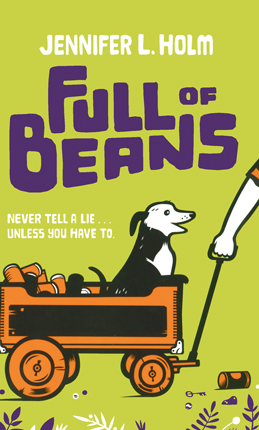| Full of beans Author: Holm, Jennifer L. | ||
| Price: $6.50 | ||
Summary:
Ten-year-old Beans Curry, a member of the Keepsies, the best marble playing gang in Depression-era Key West, Florida, engages in various schemes to earn money while "New Dealers" from Washington, D.C., arrive to turn run down Key West into a tourist resort.![]() Download a Teacher's Guide
Download a Teacher's Guide
| Accelerated Reader Information: Interest Level: MG Reading Level: 3.80 Points: 4.0 Quiz: 183695 | Reading Counts Information: Interest Level: 3-5 Reading Level: 2.60 Points: 9.0 Quiz: 69229 | |
Reviews:
Kirkus Reviews (+) (06/01/16)
School Library Journal (06/01/16)
Booklist (+) (05/15/16)
The Bulletin of the Center for Children's Books (06/16)
The Hornbook (+) (00/07/16)
Full Text Reviews:
Booklist - 05/15/2016 *Starred Review* Key West, Florida, wasn’t always a vibrant tourist destination. Holm (The Fourteenth Goldfish, 2014) turns back the clock to the 1930s, when the Great Depression had the island in its grip, leaving jobs scarce, feet bare, and houses in disrepair. Times may be tough, but they aren’t getting down Beans Curry, an enterprising 10-year-old who will do most anything to earn a dime. Accompanied by his tag-along brother Kermit and a stray dog named Termite, Beans wanders the neighborhood collecting used cans, making laundry deliveries, shooting marbles, or—if he’s lucky—seeing the latest Shirley Temple picture. Things get shaken up when a team of New Dealers descends on the town to turn it into a vacation hot spot, but Beans doesn’t appreciate these visitors, until he runs into a bit of trouble while trying to make some easy money. Holm’s talent for writing historical fiction is on full display in this story inspired by actual events. Readers will latch on to antiquated expressions (“What a bunch of applesauce!”) and marvel at aspects of Beans’ everyday life—for instance, few houses had phones, but party lines made eavesdropping a breeze. Mostly, though, they will be invested in Beans, whose tough exterior hides a vulnerable side. Interesting family and small-town dynamics further enrich this fascinating account of a young boy’s life in Florida’s “Recovery Key.” HIGH-DEMAND BACKSTORY: Holms is a three-time Newbery honoree and best-seller, plus she is touring with this title’s release, so purchase accordingly. - Copyright 2016 Booklist.
Bulletin for the Center... - 06/01/2016 The Great Depression has laid much of the country low, and Key West residents are no exception. Beans and his kid brother Kermit make a few cents turning in old bottles (even though the shop owner is a cheat) but soon discover a more profitable gig, helping a rum runner sneak his hooch off the pier in the dead of night. Beans understands full well what he’s gotten into, but between his helping the family while his dad looks for work and reveling in the thrill of diverting the community’s attention by pulling the fire alarm when the boss’s ship come in, there’s no question it’s worth it. Of course every action has its consequence, and when firefighters later fail to hustle to the scene of a residential fire thinking it’s another prank, Beans’ best friend loses his house. Beans is a thoroughly likable kid, and middle-grade readers will readily see how he gets drawn into trouble, particularly since the pay is good and his criminal boss actually treats him more fairly that the guy who buys his empty bottles. Beans’ serio-comic life of crime plays out against everyday episodes of kid shenanigans, and also within the context of a New Deal program to spruce up Key West and turn it into the tourist have it is now. Author notes offer some historical background and comment on some of the cultural references and lingo scattered throughout the text. Kids who enjoyed visiting Depression-era Alaska in Dagg’s Sweet Home Alaska (BCCB 3/16) will be entertained by a look at the same period in the opposite corner of the country. EB - Copyright 2016 The Board of Trustees of the University of Illinois.
School Library Journal - 06/01/2016 Gr 4–6—Beans Curry and his family are down on their luck. Their whole town of Key West is; it's the Great Depression, and jobs and opportunities are scarce. Beans learned at an early age that adults lie to children, and he goes on to apply that logic to the New Deal stranger who shows up in town one day, claiming the government sent him to make their dumpy town a tourist destination. Sure that the man is a lunatic, Beans ignores him as he tries to find ways to make money for his family, and sometimes even for himself. Beans evolves as a character when he realizes the role he played in a tragedy. In an effort to make up for it, he spearheads his gang into helping the New Dealers make tourism successful in Key West. Those who have read Holm's Turtle in Paradise may remember Beans as Turtle's cousin. However, familiarity with the companion book isn't necessary to enjoy this new novel, which is told in a series of vignettes that build on one another, some humorous and others poignant. The book's younger characters have an "Our Gang" feel to them, with adult characters playing decidedly backseat roles. Holm peppers the characters' vocabularies with phrases and slang from the time, which may take some getting used to. The most surprising thing about the work is that it is based on real history. Holm weaves a charming combination of old family stories into the history of the New Deal's Key West experiment, including further information about the history of the project at the end of the book. VERDICT Young readers will enjoy this heartwarming, humorous introduction to a challenging time in American history.—Juliet Morefield, Multnomah County Library, OR - Copyright 2016 Publishers Weekly, Library Journal and/or School Library Journal used with permission.



